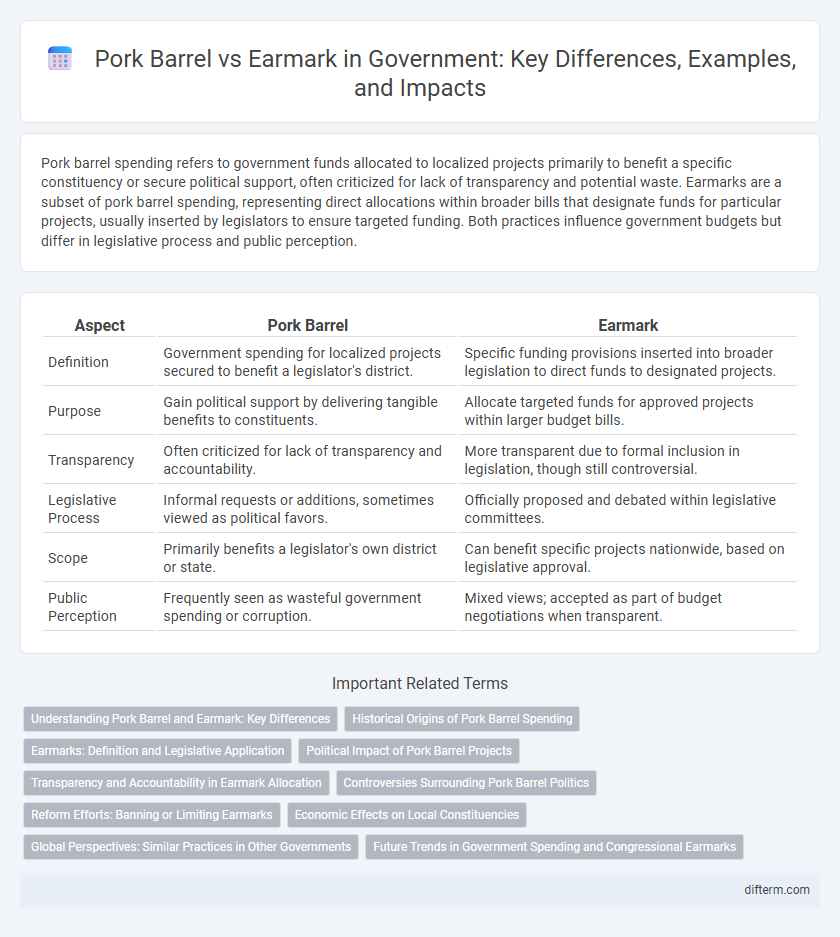Pork barrel spending refers to government funds allocated to localized projects primarily to benefit a specific constituency or secure political support, often criticized for lack of transparency and potential waste. Earmarks are a subset of pork barrel spending, representing direct allocations within broader bills that designate funds for particular projects, usually inserted by legislators to ensure targeted funding. Both practices influence government budgets but differ in legislative process and public perception.
Table of Comparison
| Aspect | Pork Barrel | Earmark |
|---|---|---|
| Definition | Government spending for localized projects secured to benefit a legislator's district. | Specific funding provisions inserted into broader legislation to direct funds to designated projects. |
| Purpose | Gain political support by delivering tangible benefits to constituents. | Allocate targeted funds for approved projects within larger budget bills. |
| Transparency | Often criticized for lack of transparency and accountability. | More transparent due to formal inclusion in legislation, though still controversial. |
| Legislative Process | Informal requests or additions, sometimes viewed as political favors. | Officially proposed and debated within legislative committees. |
| Scope | Primarily benefits a legislator's own district or state. | Can benefit specific projects nationwide, based on legislative approval. |
| Public Perception | Frequently seen as wasteful government spending or corruption. | Mixed views; accepted as part of budget negotiations when transparent. |
Understanding Pork Barrel and Earmark: Key Differences
Pork barrel refers to government spending on localized projects primarily intended to benefit a legislator's constituents and secure political support, often criticized for lack of transparency and efficiency. Earmarks, a subset of pork barrel spending, are specific provisions inserted into appropriation bills directing funds to particular projects or organizations, typically without competitive bidding. Understanding these differences highlights the nuances in government budget allocations and the debates surrounding fiscal responsibility and political influence.
Historical Origins of Pork Barrel Spending
Pork barrel spending originated in the early 19th century as legislative funds allocated by Congressmen to local projects aimed at winning voter support, often criticized for promoting unnecessary expenditures. Historically, pork barrel projects were characterized by opaque deals benefiting specific districts, whereas earmarks evolved as detailed provisions identified within broader budget bills to direct funds more transparently. The distinction reflects a shift from broad, discretionary allocations toward more explicitly justified appropriations in government fiscal policy.
Earmarks: Definition and Legislative Application
Earmarks are provisions inserted into legislation that allocate specific funds to projects, typically benefiting a legislator's district or state without going through the standard competitive or review processes. Unlike pork barrel spending, earmarks are often requested transparently and recorded in committee reports, allowing for greater scrutiny and justification during the legislative process. They facilitate targeted federal investment in local infrastructure, education, or community projects by directly linking appropriations to authorized programs within larger bills.
Political Impact of Pork Barrel Projects
Pork barrel projects often fuel political patronage by directing government funds to localized areas, securing voter loyalty and strengthening incumbents' re-election prospects. Earmarks, as targeted allocations within larger bills, enable legislators to advocate for their districts while influencing legislative negotiations and party dynamics. The political impact of pork barrel spending lies in its ability to concentrate resources for electoral advantage, sometimes at the expense of broader fiscal responsibility and policy transparency.
Transparency and Accountability in Earmark Allocation
Earmark allocation enhances transparency and accountability by requiring detailed public disclosure of project funding and beneficiaries, enabling citizens to track how government resources are utilized. Unlike pork barrel spending, which often lacks clear documentation and fosters misuse, earmarks are subjected to congressional approval and oversight, promoting responsible fiscal management. This structured process reduces opportunities for corruption and ensures legislative intent aligns with public interest.
Controversies Surrounding Pork Barrel Politics
Pork barrel politics involves allocating government funds to localized projects primarily to gain political support, often criticized for fostering corruption and mismanagement. Unlike earmarks, which are specific legislative provisions directing funds to particular projects and subject to formal scrutiny, pork barrel spending frequently lacks transparency and accountability. Controversies arise from accusations that pork barrel funds are used to secure votes rather than address genuine public needs, undermining trust in government institutions.
Reform Efforts: Banning or Limiting Earmarks
Reform efforts focusing on banning or limiting earmarks target the reduction of pork barrel spending to enhance transparency and accountability in government budgeting. Legislative proposals and executive orders have been implemented to prohibit or strictly regulate earmarks, aiming to prevent the allocation of funds for localized projects without rigorous oversight. These measures seek to curb misuse of public funds, promote equitable distribution, and restore public trust in fiscal governance.
Economic Effects on Local Constituencies
Pork barrel spending directs government funds to specific local projects, often generating immediate economic stimulation through job creation and infrastructure development within constituencies. Earmarks allocate budgetary resources for targeted legislative initiatives, enhancing local economies by supporting tailored programs and services that align with community needs. Both mechanisms influence local economic growth, but pork barrel projects tend to produce short-term benefits, whereas earmarks facilitate sustained development through strategic investments.
Global Perspectives: Similar Practices in Other Governments
Pork barrel and earmark practices are prevalent in numerous governments worldwide, serving as tools for legislators to direct funds to specific projects within their constituencies. In countries like the Philippines, pork barrel funds are allocated for local infrastructure and social programs, often sparking debates on transparency and corruption. Similarly, in the United States, earmarks enable members of Congress to secure federal funding for district-specific initiatives, highlighting global challenges in balancing localized benefits with fiscal accountability.
Future Trends in Government Spending and Congressional Earmarks
Future trends in government spending indicate a shift from traditional pork barrel projects toward more transparent congressional earmarks, emphasizing accountability and targeted investments. Earmarks are increasingly scrutinized to ensure funds support national priorities and infrastructure improvements rather than localized patronage. This evolution reflects a broader demand for legislative transparency and data-driven allocation of federal resources.
pork barrel vs earmark Infographic

 difterm.com
difterm.com